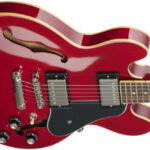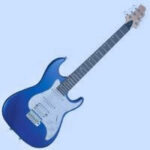Tracing the history of the guitar is like following the meandering path of a river, its source hidden in the mists of time, fed by numerous streams of cultural and instrumental evolution. While pinpointing the exact moment the “guitar” was invented is impossible, as it evolved gradually, we can journey back through history to explore its ancient ancestors and understand the fascinating story of its development.
Echoes from Mesopotamia and Ancient Egypt (3000 BCE Onwards)
Long before the term “guitar” existed, stringed instruments with lute-like characteristics were flourishing in ancient civilizations. Archaeological evidence provides glimpses into this early musical landscape. A cylinder seal dating back to the Uruk period in Southern Mesopotamia (circa 3000 BCE), now housed in the British Museum, depicts a woman playing a long-necked lute-like instrument. This image stands as one of the oldest pictorial records of such an instrument and highlights the deep roots of stringed music in the region.
Image alt text: Ancient Egyptian mural depicting a harpist playing for the god Ra, illustrating early stringed instrument traditions.
Instruments akin to lutes and guitars appeared throughout Mesopotamian and ancient Egyptian history, particularly from the 18th dynasty onwards. Found in various forms – both long and short-necked – these early instruments are documented on clay tablets and papyrus scrolls, preserved in museums like the Metropolitan Museum of Art in New York and the British Museum. These artifacts demonstrate a rich and continuous tradition of stringed instruments among the Sumerians, Akkadians, Persians, Babylonians, Assyrians, Armenians, Greeks, Egyptians, and Romans, all cultures that shaped the musical heritage of the Mediterranean and Middle East.
The Oud’s Journey Westward (711 AD)
While these early instruments laid the groundwork, the story of the guitar’s direct lineage often points to the oud. The oud, a pear-shaped, fretless stringed instrument, holds a prominent place in Middle Eastern music history. Legend attributes its invention to Lamech, a figure from the Bible, although historical evidence places its development within the broader context of ancient Mesopotamian instruments.
The oud’s influence on the guitar’s development became particularly significant with the Moorish conquest of the Iberian Peninsula in 711 AD. The Moors, establishing the Umayyad Caliphate of Al-Andalus, brought the oud to Western Europe. While instruments resembling ouds, such as the ancient Greek Pandoura and Roman Pandura, might have reached the Iberian Peninsula earlier, it was the sophisticated musical culture of Al-Andalus that truly popularized the oud in Europe.
Zyriab, a renowned oud player in Al-Andalus, played a crucial role in this dissemination. He is credited with establishing the first music conservatory in Spain and adding a fifth course of strings to the oud, enhancing its musical possibilities.
The European adaptation of the oud evolved into the lute. The word “luthier,” still used today for makers of stringed instruments, derives from the French “luth.” Unlike the oud, the lute incorporated frets, typically made of tied gut, which allowed for more precise and consistent note production. Construction techniques of the oud and lute share similarities, particularly in the use of thin wooden staves glued together to form the rounded back.
Medieval Guitars: Latin and Moorish Influences (500-1400 AD)
During the Medieval period in Europe (500-1400 AD), instruments that more closely resemble the guitar began to emerge. Guitars with 3, 4, and 5 strings were in use, indicating experimentation and diversification in instrument design. Two notable types of medieval stringed instruments in Spain were the Guitarra Latina and the Guitarra Morisca.
The Guitarra Latina, believed to have originated elsewhere in Europe before arriving in Spain, featured curved sides, a characteristic that would become a defining feature of the guitar. The Guitarra Morisca, brought to Spain by the Moors, had an oval soundbox and a distinctive soundboard with multiple sound holes.
Image alt text: Illumination from Cantigas de Santa Maria showing a Guitarra Latina and Guitarra Morisca, highlighting the visual differences between these medieval instruments.
Historical records from 1349 mention the Duke of Normandy employing musicians who played the “Guiterre Morische” (Moorish Guitar) and “Guitarra Latina” (Latin Guitar), further solidifying their presence in the musical landscape of the time. While the Guiterre Morische is considered an ancestor of the European lute and the modern Arabic oud, the Guitarra Latina is recognized as a direct precursor to the modern guitar.
The Guitar’s Gradual Emergence
The 13th and 14th centuries represent a crucial period in the guitar’s pre-history, with the Guitarra Latina standing out as a key step in its evolution. While pinpointing a definitive “invention date” for the guitar remains elusive, the historical journey reveals a fascinating process of instrument development spanning millennia. From the ancient stringed instruments of Mesopotamia and Egypt, through the influence of the oud and lute, to the emergence of medieval instruments like the Guitarra Latina, the guitar’s story is one of continuous adaptation, cultural exchange, and ultimately, the enduring human passion for music.
The question “When Was The Guitar First Invented?” therefore, doesn’t have a single answer. Instead, it invites us to explore the rich tapestry of musical history, appreciating the long and winding road that led to the instrument we know and love today.


